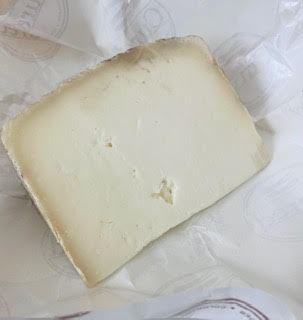 |
| Montealva Cheese |
It's hard to believe that in all the years Cured on Pearl Street in Boulder has been open, I had never been inside until a snowy day in March 2022. Despite the bitter-cold weather and just a few minutes after opening time, the place was hopping. There were people in line, waiting for their morning coffee and others getting ready to order sandwiches or other goodies. Before I got too far inside, I got distracted by the wonderful selection of chocolates, jams, and pantry items. Everything is presented beautifully, but when I eventually looked ahead, the cheese counter in the corner called to me as if a celestial light were shining upon it.
 |
| Cured sells some wonderful cheese |
The cheese section is where a limited selection of semi-soft, semi-hard, and hard cheeses sit atop an elegant gray counter. Upon closer inspection, it was obvious that Cured carries a variety of unique and unusual cheese from all over the world, and the cheesemongers there can tell you everything you need to know about each. The professional to whom I spoke was very, very knowledgeable and friendly, always a plus. He knew not just what each cheese tastes like but interesting little details about where and how the cheeses are made and aged. Initially, I went in thinking I would buy a super fancy product that I spied on their website, but it was temporarily unavailable. I hope to review that one another time once it's back in stock. There are some wonderfully intriguing selections from which to choose, so, moving to plan B, I opted for an interesting goat milk variety from Spain.
 |
| Payoya goats in Andalusia, Spain |
Montealva
For over fifty years, the craft of cheesemaking has been shared throughout the Aguilar family in Southwest Spain. Using milk from a herd of over 450 Payoya goats -- a breed that almost went extinct but is, fortunately, still surviving in the beautiful but rugged Sierra de Cadiz region -- brother and sister, Pedro and Isabel, continue their family tradition as affineurs in the town of Torrecera, Jerez. There, they create an extraordinary award-winning cheese called Montealva. This beauty was first introduced to the United States about eight years ago and has become well recognized internationally for its lovely flavor and its beautiful cotton-white interior.
 |
| Some rinds you can skip consuming |
Inside the darker decorative rind -- rind pattern is an art form in and of itself, and the woven-grass pattern on Montealva is similar to that of Manchego -- that looks and smells (and tastes, though it's not recommended to go there with this type of rind!) like it has been rolled in dirt lies a supple paste that's bright and full of flavor. There is a strong barnyard smell that escapes the moment the wrapper is opened, but once the cheese is exposed to air, the musky, stinkier aroma dissipates.
The flavor of this charming cheese is mild with more pronounced notes of citrus and a zingy tang that sneaks up on you without overwhelming your taste buds. Imagine a mild cheddar with a bit more spring in its step, one that makes you turn and take notice. The texture is creamy and smooth but slightly crumbly. Closer to the rind, the taste is more earthy, but the bulk of the interior is fruity, buttery, and sweet with just a hint of salt and nuttiness, a combination of flavors that some might call umami. The more it ages, the more the goaty flavor emerges.
 |
| Montealva is a lovely, uplifting cheese |
Keeping with the tradition of cheese made by their ancestors, the Aguilar family makes sure that Montealva remains all-natural and free from any artificial colors or preservatives. This semi-firm cheese made from pasteurized goat milk is aged two months and pairs beautifully with light toast, Spanish olives, apples, honey, marmalade, dried apricots, or fresh figs. It can be used on sandwiches to liven them up or added to baked pasta or tomato dishes. Try it in an arugula and pear salad with a creamy balsamic dressing or grated over scrambled eggs for an uplifting breakfast sure to wake you up and brighten your day.
As far as beverages, this cheese almost demands a fino sherry but pairs nicely with a Spanish rose, Pinot Grigio, Sauvignon Blanc, sparkling Cava, or a fruity Syrah. If beer is more your pleasure, Saison is a good option, as is a wheat beer.
 |
| Fino sherry pairs well with Montealva |





